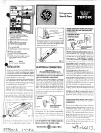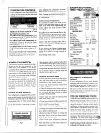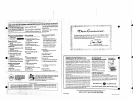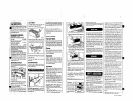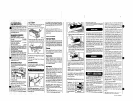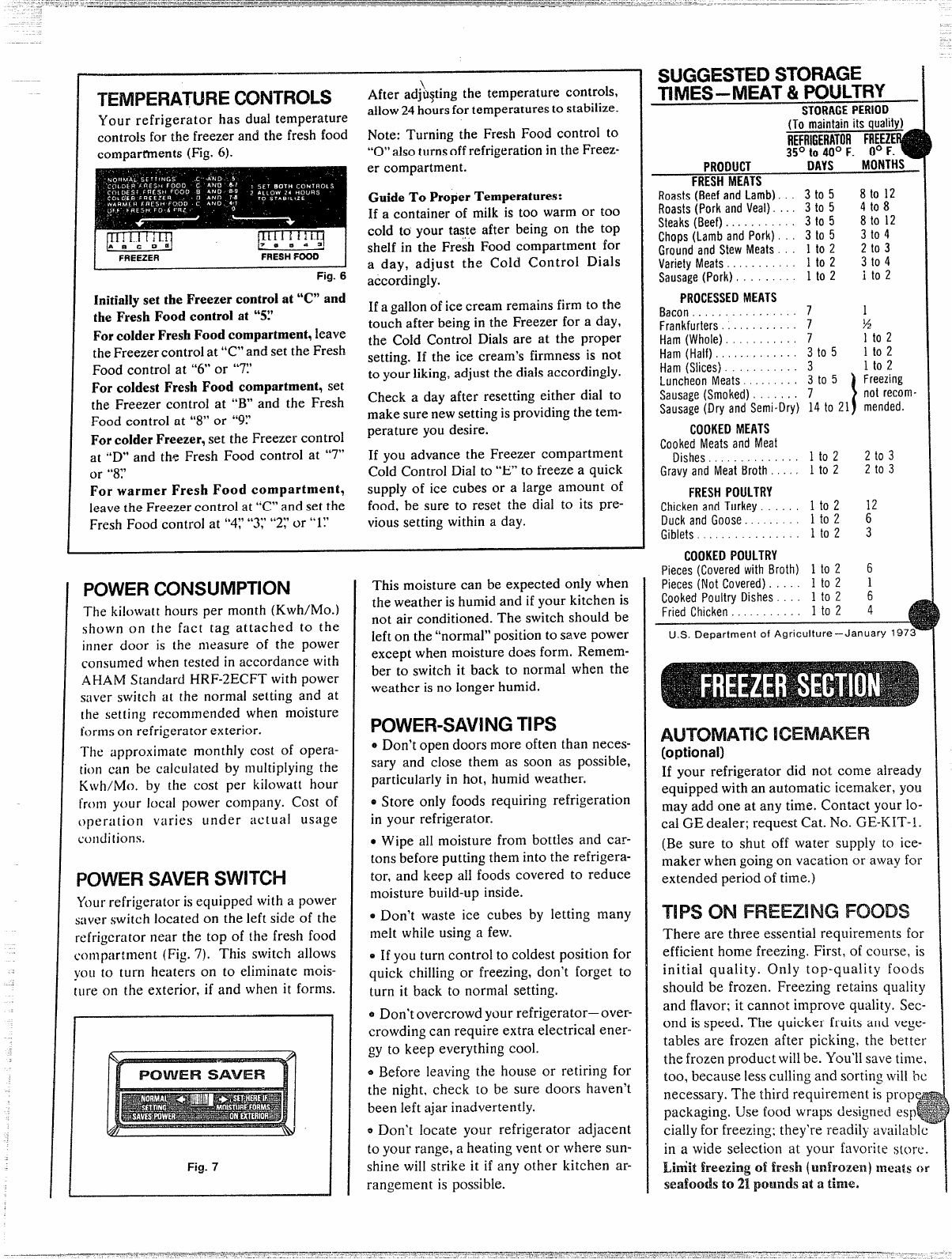
TEMPERATURE(xmrmxS
Your refrigerator has dual temperature
controls for the freezer and the fresh food
compar~ents {Fig.6).
Fig.6
Initiallyset the Freezer control at “C”and
the Fresh Food control at “5?
For colder FreshFood compartment, leave
the Freezer control at “C” and set the Fresh
Food control at “6” or “7!’
For coldest Fresh Food compartment, set
the Freezer control at “B” and the Fresh
Food control at “8” or “9?
Forcolder Freezer, set the Freezer control
at “’D”and the Fresh Food control at “7”
or “8V
For warmer Fresh Food compartment,
leave the Freezer control at ‘“C”and set the
Fresh Food control at “4:’“3;’“27or “1~’
After adj&ting the temperature controls,
allow 24hours for temperatures to stabilize.
Note: Turning the Fresh Food control to
“O”also turns off refrigeration in the Freez-
er compartment.
Guide To Proper Temperatures:
If a container of milk is too warm or too
cold to your taste after being on the top
shelf in the Fresh Food compartment for
a day, adjust the Cold Control Dials
accordingly.
If a gallon of ice cream remains firm to the
touch after being in the Freezer for a day,
the Cold Control Dials are at the proper
setting. If the ice cream’s firmness is not
to your liking, adjust the dials accordingly.
Check a day after resetting either dial to
make sure new setting is providing the tem-
perature you desire.
If you advance the Freezer compartment
Cold Control Dial to “E” to freeze a quick
supply of ice cubes or a large amount of
food, be sure to reset the dial to its pre-
vious setting within a day.
-1
POWERCONSUMPTION
The kilowatt hours per month (Kwh/Mo.)
shown on the fact tag attached to the
inner door is the measure of the power
consumed when tested in accordance with
AHAM Standard HRF-2ECFT with power
saver switch at the normal setting and at
[he setting recommended when moisture
forms on refrigerator exterior.
The approximate monthly cost of opera-
tion can be calculated by multiplying the
Kwh/Mo. by [he cost per kilowatt hour
from your local power company. Cost of
operation varies urider actual usage
uotlcfi[ionso
POWERSAVERSWITCH
Your refrigerator is equipped with a power
saver switch located on the left side of the
refrigerator near the top of the fresh food
compartment (Fig. 7). This switch allows
you to turn heaters on to eliminate mois-
ture cm the exterior, if and when it forms.
‘
Fig. 7
This moisture can be expected only when
the weather is humid and if your kitchen is
not air conditioned. The switch should be
left on the “normal” position to save power
except when moisture does form. Remem-
ber to switch it back to normal when the
weather is no longer humid.
POWER-SAVINGTIPS
e Don’t open doors more often than neces-
sary and close them as soon as possible,
particularly in hot, humid weather.
0 Store only foods requiring refrigeration
in your refrigerator.
0 Wipe all moisture from bottles and car-
tons before putting them into the refrigera-
tor, and keep all foods covered to reduce
moisture build-up inside.
0 Don’t waste ice cubes by letting many
melt while using a few.
~ If you turn control to coldest position for
quick chilling or freezing, don’t forget to
turn it back to normal setting.
~ Don’t overcrowd your refrigerator— over-
crowding can require extra electrical ener-
gy to keep everything cool.
~ Before leaving the house or retiring for
the night, check to be sure doors haven’t
been left ajar inadvertently.
e Don’t locate your refrigerator adjacent
to your range, a heating vent or where sun-
shine will strike it if any other kitchen ar-
rangement is possible.
SUGGESTEDSTORAGE
TIMES-MEAT & POULTRY
STOMGEPEfWID
(To
maintainits quatity)
REFRIGERATORFRE~
35° to40° F. 0° F.
PRODUCT
DAYS
MONTHS
FRESH MEATS
Roasts(Beef and Lamb). 3 to 5
8 to 12
Roasts (Pork and Veal). . . . 3 to 5
4
!0 8
Steaks(Beef) . . . . . . . . . . . 3 to 5
8
tO12
-.-—
Chops (Lamb and Pork) ~. . 3 to 5
Ground and Stew Meats. . . 1 to 2
Variety Meats ~. . . . . . . . . . 1 to 2
Sausage (Pork). , . . . . . . . 1
to 2
PROCESSED
MEATS
Bacon ~DJŠ... , . . . . . . . . . . . 7
Frankfurters. . . . . . . . . . . . 7
Ham (Whole). . . . . . . . . . . 7
Ham (Half) . . . . . . . . . . . . . 3 to 5
Ham (Slices). . . . . . . . . . . 3
Luncheon Meats ~ . . ~UIŠ$•Ï•ˆ•BŠ••:‚. 3 to 5
Sausage (Smoked). . . . . . . 7
Sausage (Dry and Semi-Dry) 14 to 21
COOKED MEATS
Cooked Meats and Meat
Dishes. . . ~. . . . . . . . . .
1to 2
Gravy and Meat Broth . .. ~. 1to 2
FRESH POULTRY
Chicken and Turkey. . . . . . 1 to 2
Duck and Goose. . . . . . . . . 1 to 2
Giblets. . . .. . . . . . . . . . . . 1 to 2
3 to 4
2 to 3
3 to 4
i to 2
1
%
1
to 2
1to 2
1 to 2
Freezing
not recorn”
mended.
2 to 3
2 to 3
12
6
3
6
1
COOKED POULTRY
Pieces (Covered with Broth) 1 to 2
Pieces (Not Covered). . . . . 1 to 2
Cooked Poultry Dishes . . . 1 to 2
Fried Chicken . . . . . . . . . . . 1 to 2
6
4
U.S. Department of Agriculture –January 1973-
(optional)
If your refrigerator did not come already
equipped with an automatic icernalcer, you
may add one at any time. Contact your 1o-
cal GE dealer; request Cat. No. GE-KIT-I.
(Be sure to shut off water supply to ice-
maker when going on vacation or away for
extended period of time. )
TIPS ON
There are three essential requirements for
efficient home freezing. First, of course, is
initial quality. Only top-quality foods
should be frozen. Freezing retains quality
and flavor; it cannot improve quality. Sec-
ond is speed. The quicker fruits and vege-
tables are frozen after picking, the better
the frozen product will be. You’ll save time,
too, because less culling and sorting will lx
necessary. The third requirement is prop
packaging. Use food wraps designed es
cially for freezing; they’re readily availablu
in a wide selection at your favorite s!orc.
I.Jim’itfreezing of fresh (Unirom?n) meats or
seafoods to 21pomads at a time.
-—



